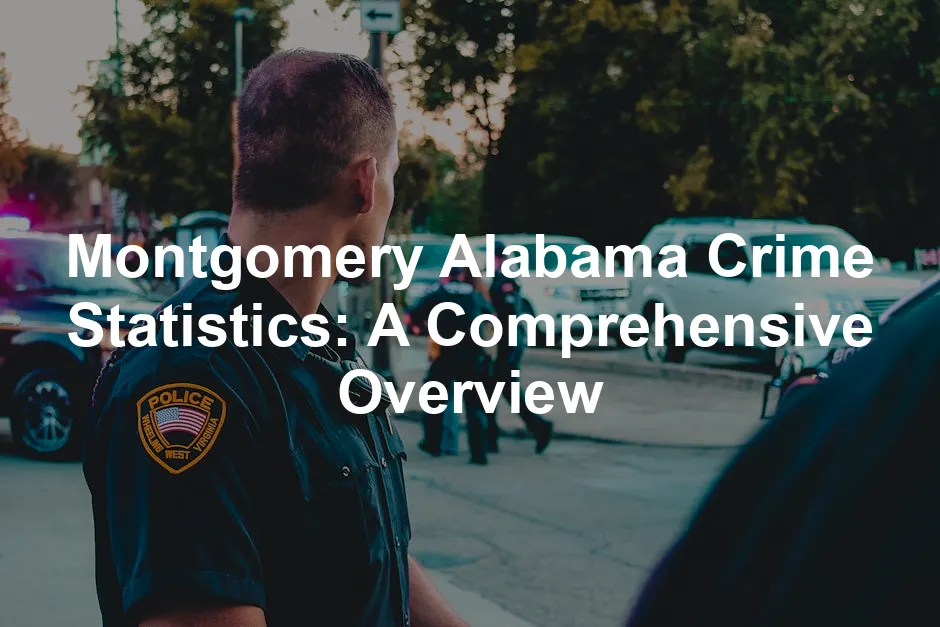Introduction
Understanding crime statistics in Montgomery, Alabama, is vital for several reasons. Residents want to feel safe. Potential movers seek to know the safety of their future home. Policymakers need solid data to make informed decisions. Crime statistics serve as the backbone of this understanding. Montgomery, known for its rich history and vibrant culture, faces challenges regarding crime. Analyzing crime statistics helps unravel these complexities. It shines a light on trends, patterns, and areas needing attention. With data in hand, we can address community concerns effectively. The sources for this analysis are diverse. They include local law enforcement reports, FBI crime data, and community surveys. Each source contributes to a clearer picture of crime in Montgomery. Expect a thorough examination of crime data, highlighting both violent and property crimes. This overview aims to equip readers with the knowledge they need to navigate Montgomery’s safety landscape. In this article, we will break down crime statistics, analyzing trends and comparisons with national averages. We will also provide insights into the implications of these statistics for community safety. Ready to dive into the numbers? Let’s get started!
Understanding Crime Statistics
What Are Crime Statistics?
Crime statistics are numerical representations of crime occurrences. They summarize the types of crimes, the frequency of these incidents, and their locations. These statistics are crucial for assessing community safety. They help identify trends over time, showing whether crime rates are rising or falling. Crime statistics typically categorize offenses into two main types: violent crimes and property crimes. Violent crimes include serious offenses like murder, rape, robbery, and aggravated assault. These crimes often have a profound impact on victims and communities. Property crimes encompass theft, burglary, vandalism, and motor vehicle theft. While these offenses might not pose an immediate threat to life, they can significantly affect community well-being. Understanding these categories helps residents and law enforcement tackle crime effectively. A closer look at crime statistics reveals patterns. Are certain neighborhoods more prone to crime? Do specific times of year see spikes in criminal activity? By answering these questions, communities can develop targeted strategies for crime prevention and safety enhancement. In summary, crime statistics provide essential insights. They inform community members, law enforcement, and policymakers about safety dynamics. With this information, proactive measures can be taken to improve public safety and reduce crime rates. To understand the psychological implications of crime, consider reading The Sociopath Next Door. This book provides insights into the ruthlessness that can exist in society, helping readers understand the darker aspects of human behavior.
Sources of Crime Data
When it comes to crime statistics, understanding the sources of data is key. Montgomery, Alabama, relies on several avenues to collect crime data. First up, we have law enforcement reports. These are the bread and butter of crime statistics. Local police departments compile reports on incidents they respond to, creating a first-hand account of crime in the community. Next, we venture into the realm of the FBI Uniform Crime Reporting (UCR) Program. This national program collects data from law enforcement agencies across the country. It provides a standardized set of statistics that allow for comparisons across different regions. Montgomery’s data, while primarily sourced locally, is included in this broader national picture. Finally, we can’t overlook local crime mapping systems. These tools offer residents a visual representation of crime in their neighborhoods. By using interactive maps, citizens can track crime trends and report issues. This empowers the community to stay informed and engaged with local safety efforts. Together, these sources create a comprehensive view of crime in Montgomery. They play an essential role in shaping public awareness and informing policy decisions. For a deeper understanding of crime data, consider The Complete Idiot’s Guide to Understanding Crime Statistics. This resource simplifies complex data into digestible information.
Overview of Montgomery’s Crime Landscape
Current Crime Rates
Montgomery’s crime rates paint a picture that’s as colorful as it is concerning. When comparing Montgomery to national averages, the data reveals some eye-catching statistics. The total crime rate in Montgomery is approximately 29% higher than the national average. That’s a hefty number, which can make anyone’s eyebrows shoot up! Breaking it down further, we see the violent crime rate sitting at about 54% above the national average. Yikes! This means that residents of Montgomery are at a greater risk of experiencing violent crimes compared to many other cities across the nation. The property crime rate estimates at 2,421 incidents per 100,000 people, significantly higher than the national figure. So, what exactly does this mean for the average Montgomery resident? It means being vigilant is a part of daily life. The statistics suggest that crime is not just a passing nuisance; it’s an ongoing issue that needs attention. If you want to delve deeper into how societal factors influence crime, check out The New Jim Crow. This book sheds light on systemic issues that contribute to crime and incarceration.
Yearly Trends
Now, let’s take a look at how crime rates in Montgomery have trended over the past decade. The data reveals some intriguing patterns. For example, certain years saw spikes in violent crimes, while others had marked decreases. To illustrate these trends clearly, here’s a table showcasing crime statistics over recent years:| Year | Violent Crime Rate | Property Crime Rate |
|---|---|---|
| 2013 | 522.49 | 4,508.1 |
| 2014 | 522.5 | 4,199.6 |
| 2015 | 523.3 | 4,199.6 |
| 2016 | 608.8 | 4,504.3 |
| 2017 | 641.4 | 4,419.9 |
| 2018 | 612.1 | 4,268.6 |

Neighborhood Crime Mapping
Crime mapping is a nifty tool for residents in Montgomery. It allows them to visualize crime incidents in their neighborhoods. Think of it as a treasure map, but instead of “X” marking the spot for gold, it highlights areas where caution is needed. This map offers insights into what types of crimes are prevalent and where they occur most frequently. Residents can access Montgomery’s crime mapping system online. By visiting the city’s official website, they can explore an interactive map. This map is updated regularly, reflecting the latest crime reports. With just a few clicks, users can see incidents such as burglaries, assaults, and more, color-coded to indicate severity. Interpreting the information is straightforward. Users can filter data by crime type and date, making it easy to spot trends. For example, if a spike in vehicle thefts is noticed in a certain neighborhood, residents can take preventive measures. Awareness is the first step towards safety.
Detailed Crime Statistics
Violent Crime Breakdown
Montgomery’s violent crime statistics tell a compelling story. In recent years, the city has grappled with a troubling rise in violent offenses. The most alarming figures reveal that the violent crime rate sits at approximately 569 incidents per 100,000 people, a staggering 54% higher than the national average. Breaking it down further, murder rates in Montgomery have been particularly concerning. The murder rate stands at 14.6 per 100,000 residents, which is alarmingly higher than the national average of 6.1. Rape incidents tally at 19.6, while robbery and assault also contribute significantly to the violent crime statistics. The robbery rate is about 196.8 per 100,000, while assaults are reported at 381 per 100,000. These statistics illustrate a pressing concern for community safety. High violent crime rates can instill fear among residents and deter potential movers. They can also lead to strained relationships between law enforcement and the community. Residents may feel less secure, fostering a sense of distrust. If you’re curious about the broader implications of violence in society, The Better Angels of Our Nature offers a compelling exploration of how violence has changed over time.
Property Crime Breakdown
Turning our focus to property crimes, Montgomery exhibits some eye-catching numbers. The property crime rate stands at 2,421 incidents per 100,000 people—again, higher than the national average of 1,739. Burglary rates are especially concerning, with estimates indicating approximately 1,032.9 burglaries per 100,000 residents. Larceny-theft is even more prevalent, with figures soaring to 2,746.4 incidents per 100,000. Additionally, vehicle thefts are reported at 489.3. Several factors contribute to these elevated property crime rates. Socioeconomic conditions play a significant role. Areas with lower income levels often see higher crime rates due to limited opportunities. Moreover, lack of community engagement can lead to increased thefts and burglaries. To gain a deeper understanding of the socioeconomic factors influencing crime, consider Freakonomics. This book explores the surprising connections between economic factors and crime.

Community Response and Law Enforcement
Law Enforcement Presence
Montgomery, Alabama, has a police force that aims to maintain public safety and respond promptly to crime incidents. The city boasts about 712 law enforcement employees, equating to roughly 3.4 officers per 1,000 residents. While this number might sound robust, it actually falls 16.1% below the Alabama state average. This disparity prompts a closer look at how effectively officers can serve the community given the population size. To combat crime, Montgomery has implemented several community-oriented programs. These initiatives focus on community policing, which fosters positive relationships between law enforcement and residents. Programs like neighborhood watch groups and youth engagement activities are designed to encourage collaboration. These efforts help to build trust, ensuring that the community feels empowered to report crimes and work alongside police officers.
Community Perceptions of Safety
Community sentiment plays a vital role in shaping the effectiveness of law enforcement. Recent surveys reveal a mix of feelings among Montgomery residents regarding their safety. Approximately 60% of surveyed individuals feel “pretty safe,” although they acknowledge some concerns. Meanwhile, about 27% express that they feel “somewhat safe,” citing noticeable safety issues. Feedback from community members regarding police effectiveness shows a range of perspectives. About 38% of respondents believe that police are very visible and responsive to their needs. On the flip side, 32% feel that while officers are present, their response times can be slow. This sentiment highlights an area for improvement, as timely responses are crucial for building trust and ensuring public confidence in law enforcement. Moreover, the crime statistics reveal a paradox. Despite the higher crime rates, a significant portion of residents still supports their local police. This support is essential for effective policing, as community cooperation is the backbone of successful crime reduction efforts. If you want to explore more about the dynamics of power and influence in society, check out The 48 Laws of Power. This book offers insights into how power dynamics can influence societal behaviors, including crime.

Conclusion
Montgomery, Alabama, presents a complex picture when it comes to crime statistics. The total crime rate is notably 29% higher than the national average, with violent crime rates soaring to 54% above this benchmark. This data showcases the pressing need for vigilance among residents. Understanding these statistics is essential for fostering a safe community. Community awareness and engagement are paramount in crime prevention efforts. When residents know what’s happening around them, they can take proactive measures. Active participation in neighborhood watch programs, community meetings, and local safety initiatives can significantly enhance public safety. The more informed the community is, the better equipped they become to respond to potential threats. For those looking to improve their personal safety, consider reading The Gift of Fear. This book provides practical advice on recognizing and responding to danger.

FAQs
What is the crime rate in Montgomery, Alabama?
As of 2022, Montgomery’s total crime rate stands at approximately 2,990 incidents per 100,000 people. The violent crime rate is about 569 per 100,000, while property crimes are estimated at 2,421 per 100,000. These statistics indicate a higher prevalence of crime compared to national averages, underscoring the importance of community vigilance.
How does Montgomery’s crime rate compare to nearby cities?
When comparing crime rates in Montgomery to nearby Alabama cities, it’s clear that Montgomery faces significant challenges. For instance, cities like Huntsville and Hoover report lower crime rates, making them seemingly safer options. In contrast, cities like Birmingham also struggle with high crime rates, indicating that Montgomery is not alone in facing these issues.
What resources are available for reporting crime in Montgomery?
Residents can report crimes or suspicious activities by contacting the Montgomery Police Department at 334-625-2532. Additionally, for non-emergencies, residents can reach the 311 Department online or call 334-625-INFO (4636), available Monday to Friday from 7 am to 5 pm.
Is Montgomery safe to live in?
Safety perceptions in Montgomery vary. Many residents report feeling “pretty safe,” despite acknowledging concerns. A survey highlighted that about 60% of residents feel generally safe, while 27% express some worries. Factors influencing safety perceptions include neighborhood environments, community engagement, and personal experiences with crime.
What can residents do to promote safety in their neighborhoods?
Residents can enhance safety by forming or joining neighborhood watch groups, participating in community safety initiatives, and attending local meetings to discuss crime concerns. Additionally, fostering open communication with law enforcement can help bridge gaps and promote a proactive approach to safety.
How often are crime statistics updated in Montgomery?
Crime statistics in Montgomery are continuously updated by local law enforcement. The Montgomery Police Department’s crime mapping system provides real-time data, reflecting the latest incidents reported. This ensures that residents have access to current information and can stay informed about safety in their neighborhoods.
If you’re interested in a deeper look at crime statistics, check out this comprehensive analysis of safety in Fremont. fremont crime statistics
All images from Pexels




